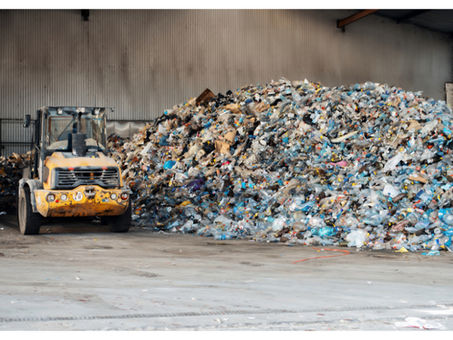top of page
Articles


Greening Up Canada’s Concrete for a More Sustainable Future
Concrete is everywhere in our homes, roads, schools, and bridges. But making it comes at a big cost. Cement, the key ingredient, contributes about 7% of global CO₂ emissions. In Canada, cement production alone accounted for 9.7 million tonnes of CO₂ in 2020, roughly 1.4% of the country’s total emissions.


Solar Thermal Air Collectors: What they are and why they matter!
The clean energy industry is constantly growing. As demand grows for clean alternatives to fossil fuels, there is a rising focus on hydro, wind, solar, and nuclear power alternatives. Using clean energy has financial benefits for the industry and individual households. Additionally, clean energy helps reduce pollution, furthering the promise of a healthier future for all Canadians. With hydro leading Canada’s clean energy sector, there are many opportunities for wind and sola


Trash to Clean Energy: How Hydrogen Can Be Made from Waste
Did you know that we can turn garbage into clean energy?


Canada’s Carbon Tax: What’s Really Going On?
Most Canadians believe climate change is real, but many don’t understand or trust the carbon tax. Let’s break down what’s happening and why the policy sparked so much debate.


Grey, Blue, or Green Hydrogen: What are the Headlines About?
Hydrogen is making headlines again for good reason. As parts of the world race toward net-zero emissions, hydrogen is hailed as a versatile, clean energy source that could well start replacing fossil fuels across industries.


Power Struggles: How to Add Renewable Energy to the Canadian Electrical Power Grid
How to Add Renewable Energy to the Canadian Electrical Power Grid


The Future of Canadian Energy - Are Solid-State Batteries Key?
Lithium-ion batteries have powered our world for decades. But they have limits. Safety risks. Short lifespans. Inefficient charging. Solid-state battery technology is a promising alternative. Are we looking at a revolution in energy storage in Canada's energy and transportation sectors? Check out the in-depth article by our researcher, Lucas Bettle , HERE . What Are Solid-State Batteries? Traditional lithium-ion batteries use liquid electrolytes. Solid-state batteries use s


97%: Fact or Fiction? Do Scientists Really Agree on Climate Change?
You’ve probably heard the claim that 97% of climate scientists agree that climate change is real and largely caused by human activity. But how do we know this is accurate? In an age of information overload and public skepticism, it’s a fair question, especially here in Canada. Here, climate science intersects directly with national policy, resource management, and Indigenous knowledge. Let’s unpack that 97% figure, how it was determined, and why the consensus is critical. Sc


Cleaner, Tastier, More Sustainable, Canadian Strawberries
Strawberries are among the most beloved fruits worldwide, but traditional strawberry farming requires significant land, water, and pesticide use. In Richmond, Virginia, a revolutionary approach is transforming how these berries are grown with vertical farming. This innovative agricultural method minimizes environmental impact while maximizing production, offering a model that could also be applied in Canada, where sustainable food production is increasingly a priority. The Be


Essentials of Electric Vehicle Batteries and Critical Materials
Electric vehicle (EV) battery production involves a complex supply chain. Every battery needs mining, refining, and assembling different materials. These materials, like lithium, cobalt, and nickel, are essential for the battery to perform well and last long enough.


The Evolution of Canada’s Plastic Bag Policy: A Call for Reinstating Paper Bags
The Canadian federal ban on plastic bags marked a turning point in our environmental policy. Introduced to combat plastic pollution, the ban aimed to reduce the environmental impact of single-use plastics, which have long been a detrimental force against ecosystems and wildlife. In the early days of this ban, grocery retailers across the nation adopted paper bags as an alternative solution to cater to the needs of customers who forgot to bring reusable bags. The Initial Shift


Environmental and Economic Impacts of Planned Obsolescence
When discussing the right to repair , it's impossible not to mention planned obsolescence. The term pertains to consumer technology designed to break after a certain amount of time. This practice has penetrated every sector, spanning technology, appliances, fashion, and automobiles alike. It's fair to say that a model centred on profiting from waste ultimately results in environmental degradation and pollution. Main Types of Obsolescence There are three main types of obsolesc


Arguments Against the Right to Repair Movement – Good for Consumers and the Environment, But Still Controversial
Advanced electronics are harder to fix. Smartphones, TVs, and cars require specialized diagnostic software and proprietary parts....


Sustainability Challenges: Can the Future of Lithium Batteries Stay Green?
What happens to the battery in your old smartphone once you get rid of it? Once an afterthought, now extracting valuable metals from discarded phones, electric vehicle batteries, and countless other gadgets that power our digital lives is a thriving industry. And as the global appetite for portable electronics and electric vehicles continues to surge, so does the mountain of spent lithium-ion batteries. But can we keep going like this? Why Lithium-ion Batteries? In the worl


Hydrogen Fuel Cell Cars: The Future – Just Not for You
Electric vehicles (EVs) are on the rise. Just look outside. You’ll probably see a Tesla or even a Rivian. Recently, new, more ecological cars have started invading even EV-averse roads of Alberta! And yet, some feel that while one revolution has just begun, another is right around the corner. Its name? Hydrogen. Progress can’t stand still. That’s true, but hydrogen? Will this supposedly magic solution make cars more eco-friendly and still have all the best qualities of gas ve


Lack of EV Charging Infrastructure Affects Adoption. But Who’s to Blame?
Electric vehicles (EVs) are an increasingly common choice for Canadians. This is good news since Canada plans to phase out combustion vehicles by 2035 and replace them with EVs. It’s ambitious — some even say unrealistic because of the lack of charging infrastructure. But who’s responsible for building the charging infrastructure for this massive transition? Is any money collected through carbon taxation used for this? The Carbon Tax The carbon tax policy is designed to


The Right to Repair – The Environmental Impact of the Treadmill of the New
Think back to pictures of your parents and grandparents from your childhood. Many households had a TV that served well for over 15 years...


Can AI Solve Climate Change? Some Risks Outweigh the Potential
The potential for AI to solve climate change is vast. But that’s not the whole story. As we look deeper, we see that some risks may not be worth taking. AI’s potential for good is undeniable, but claims that it will “solve the climate crisis” are misguided, say specialists. As a tool, it’s incredible, but utilizing it is not exactly “free.” Sam Altman, OpenAI’s CEO, admitted, “AI will require vastly more power than expected.” [10] A new report indicates that the electricity


Can AI Solve Climate Change? Good News About the Potential
AI talk is a constant media background buzz. Some preach about how AI technology supports climate change action, but skeptics warn of dire dangers. “There are a lot of really cool applications of AI in different sectors of climate change — everything from optimizing electricity grids to tracking biodiversity.” Dr. Sasha Luccioni, an AI for sustainability researcher from Quebec. [11] In 2020, the UN started actively exploring AI’s potential to help by establishing an interag


Condos and BEVs: Powering Up the Future with Charging Infrastructure
Electric vehicles are on the rise — there’s no denying it. In big cities, they are no longer an oddity, and as they become more affordable, more people buy them. Transportation is responsible for roughly 25% of emissions in Canada [9]. So, people see BEVs as a potential solution. Yet, there are still many barriers to overcome. More Canadians live in condos, apartments and other housing where a BEV owner may not have a garage charger. More BEVs Means More Condo Challenges In 2
bottom of page